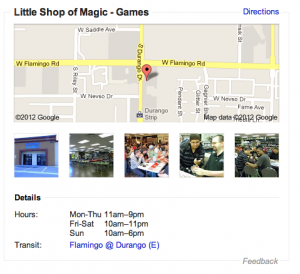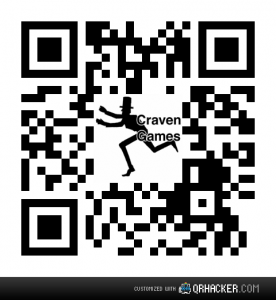GTS: Effective Marketing and Social Networking
I will be wrapping up my GAMA Trade Show coverage very shortly, having milked my attendance of nearly everything I experienced at the GTS. Here are two other seminars I attended with some advice that potential game designers or game store owners could make use of.
Creating Effective Marketing Programs
Mike Webb, VP of Marketing and Customer Service for Alliance Game Distributors, the largest game distributor in North America, gave an introduction to marketing for manufactuers in his seminar called Creating Effective Marketing Programs.
Two key points that Webb made are that good marketing is deliberate and that good marketing is ongoing. Retailers have complained to him that many manufacturers’ products go unsupported in their stores. There may be product support during the solicitation phase, but once the product is on shelves, the manufacturer ceases support. This is unfortunate because Webb described most retailers as having “absolute passion for the games”, passion that manufactuers should be tapping into.
Webb suggests manufactuers set aside some units of their games purposefully for promotional use, as demo and review copies. He also believes that there will be a shift in the paradigm of game marketing as happened with Dominion and deck-building games. He anticipates that in the next 5 years, there will be 2 or 3 new concepts or big ideas in gaming, but that only one will probably last.
Two resources he suggested were Paco Underhill’s “Why We Buy” and gmarketing.com for their guerilla tip of the day.
Michael Stackpole on Social Networking
Michael Stackpole addressed his seminar towards the needs of retailers, but game manufacturers and others (myself included) can apply his advice. The author of a large number of Star Wars and Battletech novels, Stackpole was also a developer of the hugely influential Wasteland video game, among many other games he developed. As he mentioned at the Online Retailing debate he also used to manage a Flying Buffalo game store in Arizona when the company still ran one, so he has experience in retailing.
Stackpole suggests breaking the customer base into constituencies, such as Yu-Gi-Oh players, hex grid wargamers, and role players. Efforts should be based on these constituencies and specifically target them, so a Magic player isn’t neccessarily receiving a Warmachines store update.
Customers’ Unmet Needs
Stackpole identified three unmet needs in most stores:
- Information: store owners usually possess a good deal of insider information that they can dole out in their tweets, Facebook updates, or emails.
- Validation: gamers want to know that they’ve been noticed, says Stackpole, take a picture of the top 3 winners of your tournament. They feel validated and their opponent who couldn’t make the event has even more reason to show up next time to displace them.
- Scheduled interactions: Retailers can use social networking to schedule interactions with their players. Stackpole gave the example of a store tweeting “UPS just arrived with 24 copies of the new game, 12 are spoken for, the other dozen are available to whoever gets here first.”
Social Networking Tools
Having identified those needs, Stackpole briefly covered a number of tools to help store owners take advantage of the internet:
- Store owners should own their own website and have their own domain name. There was a very archaic discussion about .coms from the attendees at this point, which I did find slightly amusing.
- Stackpole next suggested getting a Twitter account, calling it a “painless way to service your constituencies”.
- Part of Tweeting is deciding what your store’s presentation is going to be online. Stackpole used Steve Jackson Games twitter feed as an example, as each one of their tweets is initialled by the employee. Only allow access to those people you trust, Stackpole warned, because you don’t want anything done in bad taste reflecting on your company.
- Another point about the overall branding on the internet Stackpole made is that your online persona is not neccessarily you, that store owners might take on the role of facilitator, of being the butler or valet, offering friendly advice and service. For example, a store called Giant’s Games might have Gromphus the Giant inviting puny customers to try the newest offerings from Fantasy Flight this coming Saturday. While this is my shoddy example, Stackpole advised that once your online persona’s character has been constructed, to always stay in character with your tweets or posts. Customers will begin to expect whatever identity you’ve created.
- A Facebook page. Stores should consider creating a Facebook page to keep track of their customer constituencies and make it easier for their customers to get the validation they want and to supply them with information. Store owners in turn can “friendmine” those who like them on Facebook for any other customers they recognize, but store owners should do so cautiously, with no more than a dozen a day.
Email Services: Mail Chimp and Constant Contact
The combination of a store website, a Twitter account, and a Facebook page seemed to be the basics. With some contributions from other attendees, Stackpole also pointed out some other websites or technologies that retailers could use including Mail Chimp for creating and managing email lists with the first 2000 email addresses free. Constant Contact is a competing paid service that also came up. In my experience, I receive weekly or semi-weekly emails from Las Vegas’s dedicated game store Little Shop of Magic, one from Battlezone Comics, and another from Comic Oasis. Depending on their subject lines and what I initially see, I may or may not actually read them, but it does remind me of new products and the stores’ continued existences. Comic Oasis uses Constant Contact with store management typically spending 25-30 minutes each week preparing their weekly mailing. For store owner Derrick Taylor, Constant Contact is another tool to reach customers. Some of his customers “totally rely on it” for their comic and gaming information. He cited Constant Contact’s Facebook and Point of Sales integration, as well as its “pretty reasonable” price, as reasons that Comic Oasis uses the software.
Google Places and Four Square
 Kickstarter was mentioned again as a possible means for store owners to interact with their customer base, but I will be going into greater detail about the Kickstarter craze at the GAMA Trade Show in a separate, more detailed post. Google Places was another service mentioned. Basically when someone does a Google search for “game store”, a store owner should like to see a red teardrop come up next to the store name. This is a Google Place and is a means of attracting new customers and advertising a store’s existence. Store owners can get placed on Google Places easily and automatically by putting their business on Yelp or Citysearch. Another website retailers should look into is Four Square. People check in using their mobile phones at a game store, possibly for a tournament, and all of their friends can see what they are doing (and might be more likely to come themselves). Store owners can put coupons on Four Square and reward their customers for broadcasting their presence. I am more familiar with this as a guerilla means of advertising eating at a restaurant, but the concept should be easily applied to a game store.
Kickstarter was mentioned again as a possible means for store owners to interact with their customer base, but I will be going into greater detail about the Kickstarter craze at the GAMA Trade Show in a separate, more detailed post. Google Places was another service mentioned. Basically when someone does a Google search for “game store”, a store owner should like to see a red teardrop come up next to the store name. This is a Google Place and is a means of attracting new customers and advertising a store’s existence. Store owners can get placed on Google Places easily and automatically by putting their business on Yelp or Citysearch. Another website retailers should look into is Four Square. People check in using their mobile phones at a game store, possibly for a tournament, and all of their friends can see what they are doing (and might be more likely to come themselves). Store owners can put coupons on Four Square and reward their customers for broadcasting their presence. I am more familiar with this as a guerilla means of advertising eating at a restaurant, but the concept should be easily applied to a game store.
More Specific Tools
 More and more attendees shared more specific tools at the end of the Social Networking seminar. QR Codes, which had an entire seminar the day or two before the Social Networking seminar, were brought up. Store owners can place the QR code, which is a more advanced barcode scanned by smart phones, on a handout advertising an upcoming tournament, sending customers with QR-enabled devices directly to the tournament’s page. Wired.com’s QR code generator, found at QRHacker.com, lets a company place their logo in the code, as I have done to the right. Tweepi for Twitter was suggested as a way of managing Twitter followers and gremln (previously twaitter) allows for the scheduling of tweets ahead of time. Stackpole advised those using WordPress to post something regularly. His stormwolf.com is an example of a WordPress site. This site, cravengames.com, is another. WordPress users can schedule posts for times when they will be away on vacation or out of the office. The plugins akismet for comment anti-spamming and WPTouch to format WordPress blogs for mobile devices were also suggested. A final suggestion that I implemented soon after the GTS was using hostgator.com for website hosting. I had noticed that cravengames.com seemed to hang on loading from GoDaddy, my previous webhost. Now on hostgator it loads much quicker, as I would expect it to. I also created a Twitter account, not surprisingly #CravenGames, but I have yet to really utilize it. The 140 character limit is kind of antithetical to Craven Games and in-depth information.
More and more attendees shared more specific tools at the end of the Social Networking seminar. QR Codes, which had an entire seminar the day or two before the Social Networking seminar, were brought up. Store owners can place the QR code, which is a more advanced barcode scanned by smart phones, on a handout advertising an upcoming tournament, sending customers with QR-enabled devices directly to the tournament’s page. Wired.com’s QR code generator, found at QRHacker.com, lets a company place their logo in the code, as I have done to the right. Tweepi for Twitter was suggested as a way of managing Twitter followers and gremln (previously twaitter) allows for the scheduling of tweets ahead of time. Stackpole advised those using WordPress to post something regularly. His stormwolf.com is an example of a WordPress site. This site, cravengames.com, is another. WordPress users can schedule posts for times when they will be away on vacation or out of the office. The plugins akismet for comment anti-spamming and WPTouch to format WordPress blogs for mobile devices were also suggested. A final suggestion that I implemented soon after the GTS was using hostgator.com for website hosting. I had noticed that cravengames.com seemed to hang on loading from GoDaddy, my previous webhost. Now on hostgator it loads much quicker, as I would expect it to. I also created a Twitter account, not surprisingly #CravenGames, but I have yet to really utilize it. The 140 character limit is kind of antithetical to Craven Games and in-depth information.
A Few Further Points on Social Networking
“You’ll have a friend in a fit of pique who will unfriend you and this is supposed to crush you.”
There was also a light discussion on the realities of social networking. One attendee pointed out that store owners should ask for permission before posting pictures on their websites or Facebook pages (or even tagging players at tournaments) because they might be “closet gamers”. I had never thought of myself as in the closet before, but I did appreciate what he was suggesting. I have my own unflattering unsolicited pictures on several websites. Another thing that Mike Stackpole mentioned that really stood out to me and amused me was when he said of social networking, “You’ll have a friend in a fit of pique who will unfriend you and this is supposed to crush you.” All in all, the seminar was a very informative overview of the basics of social networking. Perhaps there will be a 201 seminar at next year’s GAMA Trade Show.




Pingback:GAMA Trade Show Crowdfunding: Kickstarter and Indiegogo | Craven Games: In-Depth Tabletop Games Coverage
Pingback:The 2012 GAMA Trade Show: What Went On and Who Did It | Craven Games: In-Depth Tabletop Games Coverage